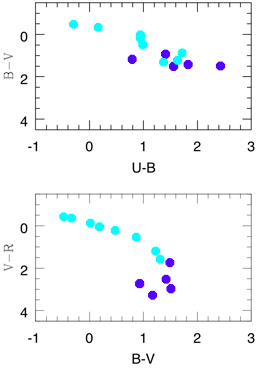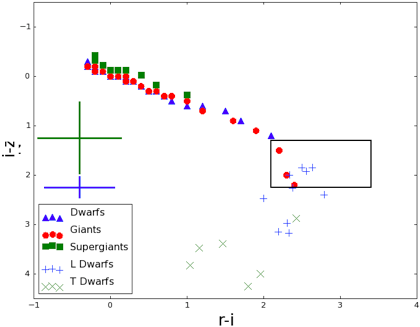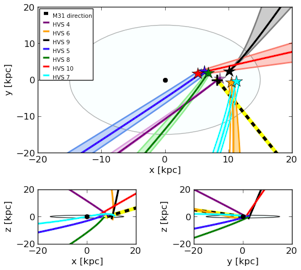Research Interests

The larger points overplotted in the figure above are the colors of confirmed late-type M giants-- calculated from the Bruzual-Persson-Gunn-Stryker stellar atlas using the IRAF Synphot task (green), from the Catalogue of Stellar Spectral Classifications of Skiff (2010) (blue), and calculated directly from the spectra obtained by Kirkpatrick et al. (in prep) (red).

As a student at Hofstra University, under the advisement of Dr. Stephen Lawrence, I worked on a project where I searched for the light echoes of supernova 1987A. The models of Type II supernovae predict that a supersonic shock of UV radiation would have been released through the progenitor star very shortly after core collapse. While the brief UV flash itself can no longer be detected, the UV light that was emitted can still be detected as it scatters off nearby material creating these light echoes. The image to the right shows the optical light echo we were able to recover, however we were unable to identify such features in the ultraviolet wavelengths.


A significant fraction of the stellar component of a galaxy cluster is not confined to any galaxy. These stars between galaxies form luminous halos, called intracluster light, with very low surface brightness that can extend out to several hundred kiloparsecs. It is commonly thought that intracluster stars are either stripped from galaxies as the cluster assembles via high speed galaxy encounters, interactions with the galaxy cluster potential, or by tidal stripping within in-falling galaxy groups.
I became interested in the idea that such a population of stars might exist within our own Local Group, called intragroup stars (IGS), and developed a technique to search for these stars based on their location in color space. This technique identifies the very latest M giants (M7 III-M10 III) by the extremely red colors they exhibit in the SDSS riz bands.
Below is a figure showing the colors of the standard M dwarfs (cyan) and M giants (blue) from the Bruzual-Persson-Gunn-Stryker stellar atlas plotted to the right in the Johnson-Cousins filter set.

The figure to the left shows the r-i and i-z colors of solar metallicity spectral standard stars of Covey et al. (2007) along with L and T dwarfs of Hawley et al. (2002). The black rectangle denotes the small region of color space that contains very late-type M giants and potential contamination from early L dwarfs.


Complete IGS candidate list available here.


Hills (1988) predicted that hypervelocity stars (HVSs) should exist as a result of binary stars interacting with a central SMBH-- one member of the binary transfers energy and angular momentum to the SMBH and subsequently becomes bound in orbit, while the companion star is flung from the galaxy at velocities approaching 1000 km/s. Then, Brown et al. (2005) discovered the very first HVS with a radial velocity of 700 km/s. To date, there are only 18 confirmed HVSs, all of which are massive B-type stars with radial velocities suggestive of a Galactic center origin. However, this three-body mechanism should not preferentially eject only the most massive stars, and we should expect HVSs of all spectral types.
Within the SEGUE G & K dwarf sample of Schlesinger et al. (2012), we identified 20 HVS candidates, each with a total velocity exceeding 600 km/s, well above the escape velocity of the Galaxy. Employing a multi-component, static, analytic model of the Milky Way, we integrated the orbits of our HVS candidates back in time and found that, surprisingly, none of them originate from the center of the Galaxy.
The figure to the left shows 2D projections of the Milky Way. The black dot marks the location of the central SMBH and the pale blue ellipse is provided to give the rough scale of the Galactic disk. Each of the colored stars shows the observed positions of the HVS candidates, and the corresponding colored wedges show the range of possible orbits, back in time, for each of the candidates. None of our HVS candidates appear to be coming from the SMBH. Furthermore, the black dashed line points to the position of M31 1 Gyr ago (chosen to correspond to the estimated HVS flight time), and our candidates can not be explained by ejection via three-body interactions with the SMBH in M31.
The figure to the right shows the metallicity distribution function of our HVS candidates compared to those of disk G & K dwarfs, globular clusters, and the bulge. Based on the metallicity of our candidates none of these potential sources can be conclusively ruled out(except perhaps the metal-poor globular cluster population).
